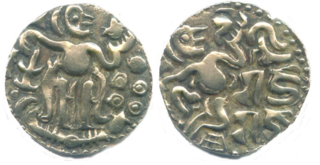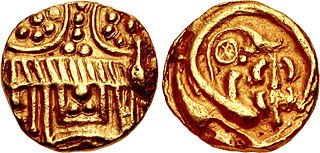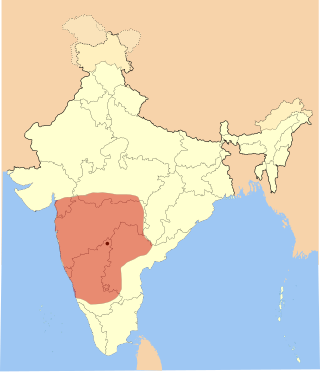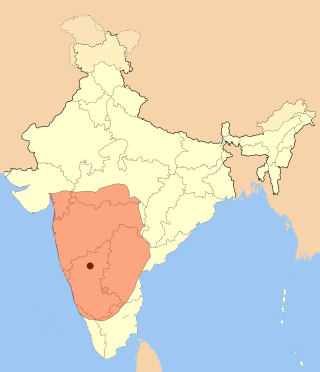
Kulottunga I also spelt Kulothunga, born Rajendra Chalukya, was a Chola Emperor who reigned from 1070 CE to 1122 CE succeeding his cousin Athirajendra Chola. He also served as the Eastern Chalukya monarch from 1061 CE to 1118 CE, succeeding his father Rajaraja Narendra. He is related to the Chola dynasty through his mother's side and the Eastern Chalukyas through his father's side. His mother, Ammangaidevi, was a Chola princess and the daughter of emperor Rajendra I. His father was king Rajaraja Narendra of the Eastern Chalukya dynasty who was the nephew of Rajendra and maternal grandson of Rajaraja I. According to historian Sailendra Nath Sen, his accession marked the beginning of a new era and ushered in a period of internal peace and benevolent administration.

Rajadhiraja I was a Chola emperor, as the successor of his father, Rajendra I. He was the only Chola emperor who was killed while leading his army in war, and although he had a short reign, he helped his father conquer several territories as well as to maintain the Chola authority over most of Sri Lanka, Eastern Chalukya and Kalinga, among others. He also established imperial relations with overseas allies despite a series of revolts in the territory.

The Chola dynasty was a Tamil dynasty originating from southern India. At its height, it ruled over an expansive maritime empire known as the Chola empire. The earliest datable references to the Chola are from inscriptions dated to the 3rd century BCE during the reign of Ashoka of the Maurya empire. The Chola empire was at its peak and achieved imperialism under the Medieval Cholas in the mid-9th century CE. As one of the Three Crowned Kings of Tamilakam, along with the Chera and Pandya, the dynasty continued to govern over varying territories until the 13th century CE.
Vengi or Venginadu is an Indian region in modern-day Andhra Pradesh spread over the Godavari and Krishna river deltas. The capital city of Vengi is located at Pedavegi near Eluru. Vengi was the most prominent city in Ancient Andhra for nearly seven centuries. Vengi served as the capital for Andhra dynasty like Salankayanas This region was part of Ashoka's Mauryan Empire in the mid-3rd century BCE. After the Mauryan Empire collapsed in 185 BC, the region was dominated by the Satavahanas, who were succeeded in Vengi by the Andhra Ikshvakus. Around 300 CE, the Andhra Ikshvakus were replaced by the Salankayanas. In the late 5th century, the Salankayanas were annexed by the Vishnukundinas.

Vikramaditya VI became the Western Chalukya King after deposing his elder brother Someshvara II, a political move he made by gaining the support of Chalukya vassals during the Chola invasion of Chalukya territory. Vikramaditya's reign is marked with the abolishment of the Saka era and the start of the Chalukya-Vikrama era. He was the greatest of the Western Chalukya kings and had the longest reign in the dynasty. He earned the title Permadideva and Tribhuvanamalla. He had several queens who ably assisted him in administration. One of his queens, Chandala Devi, a princess from the Shilahara ruling family of Karad was called Abhinava Saraswati for her skills as an artist. Queen Kethala Devi administered the Siruguppa region and Savala Devi was in charge of an Agrahara in Naregal. According to the historian Kamath, Vikramaditya VI was a "great king who ruled over South India" and he finds a "pride of place in Karnataka history". More inscriptions in Kannada are attributed to Vikramaditya VI than any other king prior to the Vijayanagara era.

Rajendra II often referred to as Rajendradeva Chola was a Chola emperor who reigned from 1052 CE to 1064 CE. Rajendra II succeeded his brother Rajadhiraja I after his death at the Battle of Koppam. Rajendra had served as a Co-regent under his brother from 1044 CE to 1052 CE. When he acceded the throne, the Chola Empire was at its peak stretching from Southern India to Vengai(Bengal) to parts of Southeast Asia. Rajendra has maintained the territories of his predecessor. During his reign, the Chola Empire was prosperous and had a large influence in trade throughout the Indian Ocean.

Virarajendra was a Chola emperor, who spent a major part of his life as a subordinate to two of his elder brothers Rajadhiraja I and Rajendra II, he is the son of Rajendra I. During his early reign he granted the maintenance of a school to study the Vedas, Sastras and grammar; a hostel was provided for the students. A hospital named Virasolan was also provided by him for the sick people. The famous grammatical work in Tamil, Virasoliyam was written by Buddhamitra during his reign.
Athirajendra reigned for a very short period of few months as the Chola king succeeding his father Virarajendra. His reign was marked by civil unrest, possibly religious in nature. Athirajendra was last clan of Chola dynasty. He was killed in the religious chaos. Athirajindra and Virarajendra interfered in the Vengi succession disputes after the Vengi king Rajaraja Narendra, who was closely related to the Chola clan through his mother Kundavai, a daughter of Rajaraja Chola, died in 1061 CE. The Vengi throne went to Saktivarman II in a palace coup. The Cholas wanted the Chola influence re-established in Vengi. Saktivarman II was killed, but Vijayaditya, Saktivarman's father assumed the throne and repulsed the Chola attempts at unseating him. Vijayaditya however accepted to serving as a Chola vassal.

The Chola Empire, which is often referred to as the Imperial Cholas, was a medieval Indian, thalassocratic empire that was established by the Pottapi branch of the Chola dynasty that rose to prominence during the middle of the ninth century CE and united southern India under their rule.

Vikrama Chola, known as Kō Parakēsari Varman, was a 12th-century ruler of the Chola Empire in southern India. He succeeded his father Kulothunga I to the throne. Vikrama Chola was crowned as the heir-apparent by his father early in his life. He was appointed as viceroy of the Vengi province in 1089 C.E., succeeding his brother Rajaraja Chodaganga. Vikrama during his tenure successfully managed to check the ambitions of the Western Chalukya Vikramaditya VI on the Vengi kingdom.Vikrama Chola inherited the territories which included Tamil Nadu and some parts of Andhra Pradesh.

Eastern Chalukyas, also known as the Chalukyas of Vengi, were a dynasty that ruled parts of South India between the 7th and 12th centuries. They started out as governors of the Chalukyas of Badami in the Deccan region. Subsequently, they became a sovereign power, and ruled the Vengi region of present-day Andhra Pradesh until c. 1001 CE. They continued ruling the region as feudatories of the Medieval Cholas until 1189 CE.

Jayasimha II succeeded his brother Vikramaditya V on the Western Chalukya throne. He had to fight on many fronts, against the Cholas of Tanjore in the south and the Paramara dynasty in the north, to protect his kingdom. His rule however was an important period of development of Kannada literature. The Brahmin Kannada writers Durgasimha, Chavundaraya II and Kavitavilasa were in his patronage. Chandraraja, a Brahmin writer on erotics was in the court of Machiraja, a vassal of Jayasimha II. The Jain Sanskrit scholar Vadiraja was in Jayasimha II's court and wrote two epics, on logic, and a commentary on an earlier Jain text. His queen Suggaladevi was a disciple of the Kannada saint-poet Devara Dasimayya.

Someshvara I was a king of the Western Chalukyas. Also known as "Ahavamalla" or "Trilokamalla", Someshvara succeeded his father Jayasimha II to the throne.

Someshvara II who was administering the area around Gadag succeeded his father Someshvara I (Ahavamalla) as the Western Chalukya king. He was the eldest son of Someshvara I. During his reign Someshvara II was constantly under threat from his more ambitious younger brother Vikramaditya VI. Eventually Someshvara was deposed by Vikramaditya VI.

The Western Chalukya Empire ruled most of the western Deccan, South India, between the 10th and 12th centuries. This Kannadiga dynasty is sometimes called the Kalyani Chalukya after its regal capital at Kalyani, today's Basavakalyan in the modern Bidar District of Karnataka state, and alternatively the Later Chalukya from its theoretical relationship to the 6th-century Chalukya dynasty of Badami. The dynasty is called Western Chalukyas to differentiate from the contemporaneous Eastern Chalukyas of Vengi, a separate dynasty. Prior to the rise of these Chalukyas, the Rashtrakuta empire of Manyakheta controlled most of Deccan and Central India for over two centuries. In 973, seeing confusion in the Rashtrakuta empire after a successful invasion of their capital by the ruler of the Paramara dynasty of Malwa, Tailapa II, a feudatory of the Rashtrakuta dynasty ruling from Bijapur region defeated his overlords and made Manyakheta his capital. The dynasty quickly rose to power and grew into an empire under Someshvara I who moved the capital to Kalyani.
Velanati Chodas or Velanati Durjayas were a dynasty who ruled over parts of the Andhra Pradesh in the 12th century. They were Vassals of Later Cholas and Western Chalukyas and ruled over the region of Kammanadu in modern Guntur district.

The Chalukya dynasty was a Classical Indian dynasty that ruled large parts of southern and central India between the 6th and the 12th centuries. During this period, they ruled as three related yet individual dynasties. The earliest dynasty, known as the "Badami Chalukyas", ruled from Vatapi from the middle of the 6th century. The Badami Chalukyas began to assert their independence at the decline of the Kadamba kingdom of Banavasi and rapidly rose to prominence during the reign of Pulakeshin II. After the death of Pulakeshin II, the Eastern Chalukyas became an independent kingdom in the eastern Deccan. They ruled from Vengi until about the 11th century. In the western Deccan, the rise of the Rashtrakutas in the middle of the 8th century eclipsed the Chalukyas of Badami before being revived by their descendants, the Western Chalukyas, in the late 10th century. These Western Chalukyas ruled from Kalyani until the end of the 12th century.
The Battle of Koppam was a battle fought between the Medieval Chola kings Rajadhiraja Chola and Rajendra Chola II with the Chalukya king Someshvara I in 1054, or in 1052 according to Sen. The site of the battle has been identified as Koppal by C.R. Krishnamacharlu and this has been accepted by Sastri and Dr. B.R Gopal. Though the Cholas were successful in the battle, the king and supreme commander, Rajadhiraja I lost his life in the battlefield and was succeeded to the throne by his younger brother, Rajendra Chola II.

The Medieval Chola emperor Rajendra Chola I led an Chola Expedition of the Ganges between 1019 and 1021. The expedition traversed the states of Vengi, Kalinga, Madhya Pradesh, Jharkhand, Odda, Bengal, Bihar and Uttar Pradesh culminating with their arrival at the Ganges river. The Chola victory over the Pala king Mahipala I is considered to be the climax of the expedition. In 1019 CE, Rajendra's forces marched through Kalinga towards the river Ganga. In Kalinga the Chola forces defeated Indraratha the ruler of the Somavamsi dynasty. The Chola army eventually reached the Pala kingdom of Bengal where they defeated Mahipala. The Chola army also defeated the last ruler of the Kamboja Pala dynasty Dharmapala of Dandabhukti. The Chola army went on to raid East Bengal and defeated Govindachandra of the Chandra dynasty and invaded Bastar region.
The Battle of Kudal-Sangamam was fought in 1062 CE by the forces of the Chola king Rajendra Chola II and the Western Chalukya king Someshvara I at Kudal-Sangamam, where the Krishna and the Tungabhadra meet.













